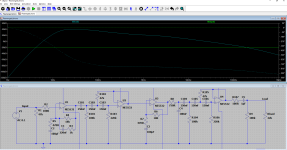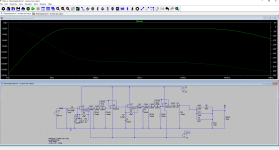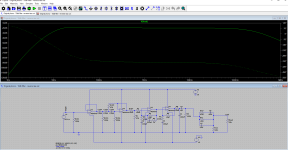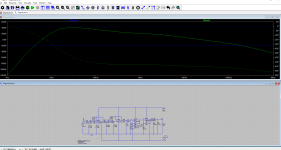Right. Thanks to Mooly's guide I have gotten LTspice going and managed to simulate something that looks like my schematic.

To my untrained eye things look ok. For reference, here is Rod's frequency response graph:

The two look close enough to me.
Frequency response is up 40dB at 20Hz and down to 0dB at 20kHz according to the sim.
Phase looks ok to me. Fairly flat across the audio band except at the bottom where I don't imagine it is as much of an issue.
For the sake of due diligence I will rearrange it back to the original schematic and see if anything changes.

To my untrained eye things look ok. For reference, here is Rod's frequency response graph:
The two look close enough to me.
Frequency response is up 40dB at 20Hz and down to 0dB at 20kHz according to the sim.
Phase looks ok to me. Fairly flat across the audio band except at the bottom where I don't imagine it is as much of an issue.
For the sake of due diligence I will rearrange it back to the original schematic and see if anything changes.
To me, that's not enough reason to use it. There's no doubt that it's a very powerful simulator, but the UI is just so awful that I refuse to use it.Seems to me that ltspice is the 'industry standard' here on DIYA
I happened to bump into Bob Cordell at BAF today and he mentioned QSPICE: https://www.qorvo.com/design-hub/design-tools/interactive/qspice
Apparently it's done by the same guy who originally wrote LTSpice. Could be worth a look.
Tom
I recommend building an inverse-RIAA filter in simulation. Attach that at the output of your circuit. If the circuit meets RIAA specs you should see a straight line.Right. Thanks to Mooly's guide I have gotten LTspice going and managed to simulate something that looks like my schematic.
Tom
For me it's the only UI that I like and can work with, efficient like nothing else. All other schematic editors are PITA, especially Altium's but KiCad isn't any better.There's no doubt that it's a very powerful simulator, but the UI is just so awful that I refuse to use it.
Yeah. I'm not a fan of Altium. KiCAD is nice.
I'm not a fan of software where more time was spent on redefining the shape of the mouse cursor than on making the UI intuitive to use. Heck, even Specre is better than LTspice.
Tom
I'm not a fan of software where more time was spent on redefining the shape of the mouse cursor than on making the UI intuitive to use. Heck, even Specre is better than LTspice.
Tom
So with a reverse RIAA filter on the output response is fairly flat.

Slightly flatter if the rumble filter is changed to an 18db filter:

All looks good there to me.
Need I be concerned with the phase shift below 100Hz?
From my admittedly noob brain, this is fairly unavoidable with all of the filters involved.

Slightly flatter if the rumble filter is changed to an 18db filter:

All looks good there to me.
Need I be concerned with the phase shift below 100Hz?
From my admittedly noob brain, this is fairly unavoidable with all of the filters involved.
You could reduce the y axis scale from 180 dB to something like 50 dB to get a better idea how flat the response is really 😊response is fairly flat
You can't have filtering without phase shift. Don't want the phase shift? Get rid of the rumble filter.Need I be concerned with the phase shift below 100Hz?
Tom
That's what I thought. Thanks for the confirmation.
I have made a bit of a pivot towards the pearl 3. A far more sophisticated design imo.
Since no stand alone pcbs ate available I'm back to pcb design with everything discussed above still relevant.
I have made a bit of a pivot towards the pearl 3. A far more sophisticated design imo.
Since no stand alone pcbs ate available I'm back to pcb design with everything discussed above still relevant.
A big part of the phono playback rumble is usually out of phase, that's why some designs offer a differential rumble filter (often called an "elliptic" filter) and/or downmixing to mono for bass signals. By this, the standard high-pass can be reduced to 1st or 2nd order, just enough to prevent potential clipping.Need I be concerned with the phase shift below 100Hz?
From my admittedly noob brain, this is fairly unavoidable with all of the filters involved.
- Home
- Amplifiers
- Power Supplies
- Regulators right beside OPamps pins
